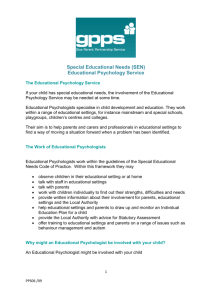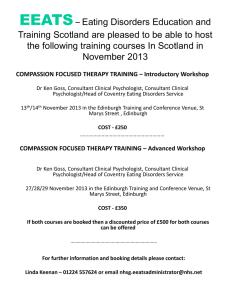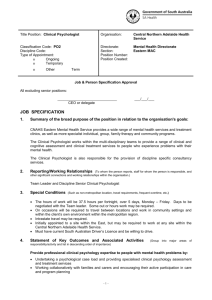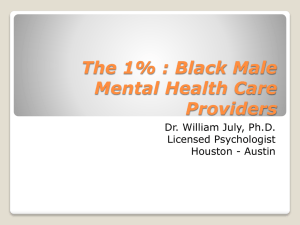Modules 1, 2 and 3 Practice Quizzes
advertisement
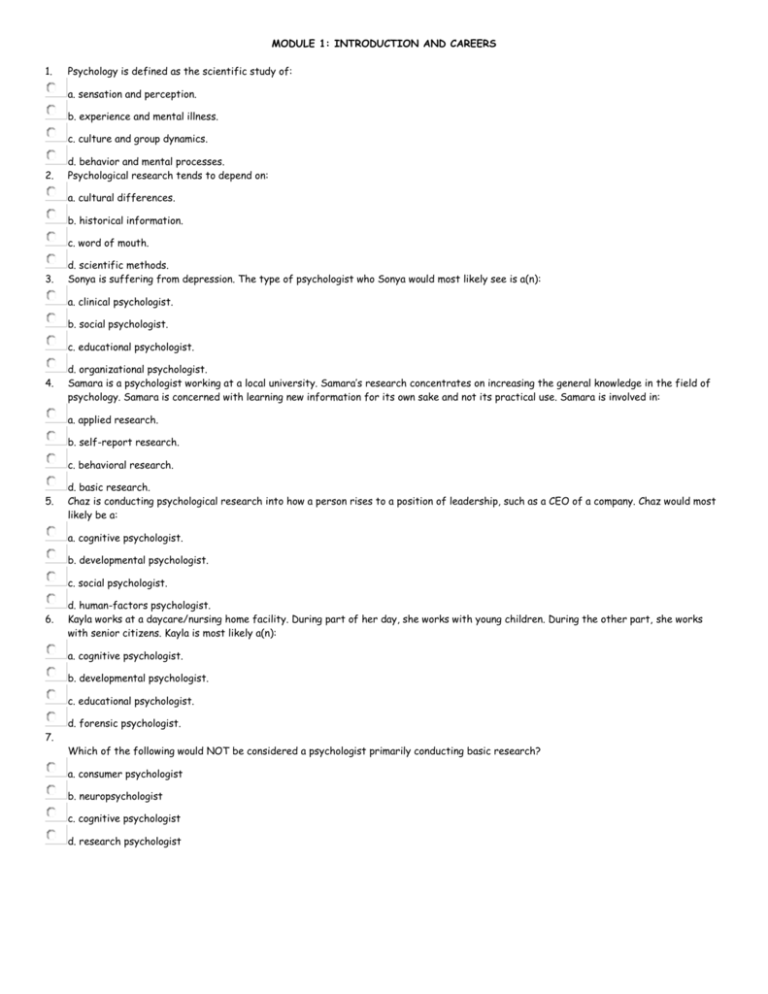
MODULE 1: INTRODUCTION AND CAREERS 1. Psychology is defined as the scientific study of: a. sensation and perception. b. experience and mental illness. c. culture and group dynamics. 2. d. behavior and mental processes. Psychological research tends to depend on: a. cultural differences. b. historical information. c. word of mouth. 3. d. scientific methods. Sonya is suffering from depression. The type of psychologist who Sonya would most likely see is a(n): a. clinical psychologist. b. social psychologist. c. educational psychologist. 4. d. organizational psychologist. Samara is a psychologist working at a local university. Samara’s research concentrates on increasing the general knowledge in the field of psychology. Samara is concerned with learning new information for its own sake and not its practical use. Samara is involved in: a. applied research. b. self-report research. c. behavioral research. 5. d. basic research. Chaz is conducting psychological research into how a person rises to a position of leadership, such as a CEO of a company. Chaz would most likely be a: a. cognitive psychologist. b. developmental psychologist. c. social psychologist. 6. d. human-factors psychologist. Kayla works at a daycare/nursing home facility. During part of her day, she works with young children. During the other part, she works with senior citizens. Kayla is most likely a(n): a. cognitive psychologist. b. developmental psychologist. c. educational psychologist. 7. d. forensic psychologist. Which of the following would NOT be considered a psychologist primarily conducting basic research? a. consumer psychologist b. neuropsychologist c. cognitive psychologist d. research psychologist 8. Kristen is having problems remembering her locker combination. Which type of psychologist would be most interested in Kristen’s memory problem? a. developmental b. forensic c. consumer 9. d. cognitive Jim is a researcher for a local business. He believes that research should be “problem centered” in that it tries to solve specific problems in the world. Jim is an advocate of: a. applied research. b. self-report research. c. behavioral research. d. basic research. 10. Television shows such as CSI and Law and Order, Special Victims Unit, which center on professionals investigating crime scenes, usually include: a. human-factor psychologists. b. forensic psychologists. c. social psychologists. 11. d. cognitive psychologists. Which of the following would most likely design an ergonomic computer keyboard? a. cognitive psychologist b. social psychologist c. health psychologist d. human-factors psychologist 12. As the owner of a large corporation, Morgan needs to constantly hire new workers. Morgan decides to hire a consultant to help in the hiring process. She more likely would use a(n): a. industrial/organizational psychologist. b. human-factors psychologist. c. consumer psychologist. d. forensic psychologist. 13. Allie is a psychologist employed by a producer of household products. Her primary job is to determine which type of display in a grocery store helps sell the most of her company’s products. Allie is most likely a(n): a. industrial/organizational psychologist. b. human-factors psychologist. c. forensic psychologist. d. consumer psychologist. 14. Tyler was involved in an auto accident and is in need of assistance relearning how to talk. Tyler would most likely visit a(n): a. health psychologist. b. rehabilitation psychologist. c. consumer psychologist. d. industrial/organizational psychologist. 15. Which of the following would most likely help someone stop smoking? a. consumer psychologist b. health psychologist c. rehabilitation psychologist d. human-factors psychologist MODULE 2: HISTORY AND PERSPECTIVES 1. Who is considered the “father of psychology” by his establishment of the first psychology lab? a. Wilhelm Wundt b. William James c. Sigmund Freud 2. d. E. B. Tichener Titchener believed that psychology should study the basic elements of conscious experience. This school of thought is referred to as: a. behaviorism. b. psychoanalysis. c. functionalism. 3. d. structuralism. Which of the following books would most likely be written by someone who follows the Gestalt school of psychology? a. The Observation of Behavior b. The Whole Is More Than the Parts c. How the Mind Really Works 4. d. The Structure of Consciousness William James: a. was the first American psychologist. b. wrote the first psychology textbook. c. believed psychology should study the functions of consciousness. 5. d. all of the above The functionalists were influenced by: a. the humanists’ stress on studying only observable behavior. b. Pavlov’s study of problem solving in chimps. c. Darwin’s theory of evolution. 6. d. Rogers’ studies with “Little Albert”. Which of the following is considered the founder of psychoanalysis? a. Wilhelm Wundt b. William James c. Sigmund Freud 7. d. E. B. Tichener The behaviorist believed: a. psychology should emphasize the study of healthy people. b. psychology should only study observable and objectively described acts. c. psychology should study the self examination of inner ideas and experiences. 8. d. all of the above Tina believes that psychology should emphasize the potential for growth of each human being and the individual’s freedom to make their own decisions. Tina would most likely be labeled a: a. humanist. b. behaviorist. c. functionalist. d. structuralist. 9. Who established the first psychology lab in the United States? a. G. Stanley Hall b. William James c. Francis Cecil Sumner d. Mary Whiton Calkins 10. Jim, in his approach to psychology, stresses that individuals continually strive to reach their full potential. Jim would be described as coming from which perspective of psychology? a. social-cultural b. behavioral c. humanistic 11. d. cognitive Shandi studies how rewards and punishments influence the behavior of humans and animals. Shandi most likely belongs to which psychological perspective? a. behavioral b. humanistic c. cognitive d. biological 12. Sue believes the field of psychology should study various methods of problem solving, how people memorize facts, and what changes our thinking structure. Sue would be described as coming from which perspective of psychology? a. social-cultural b. behavioral c. humanistic d. cognitive 13. The cognitive perspective tends to emphasize: a. thought processes. b. the unconscious mind. c. observable behavior. d. striving for superiority. 14. Mitch believes that an addiction to cigarette smoking is due to physiological changes to nicotine in the body. Mitch most likely follows which psychological perspective? a. behaviorist b. humanist c. cognitive d. biological 15. Martin Seligman felt the field of psychology should emphasize: a. the curing of mental illness. b. making life more productive and fulfilling. c. self-report reflections over the scientific method. d. how evolution has changed human behavior. MODULE 3: NATURE AND NURTURE IN PSYCHOLOGY 1. Marcus is a psychologist who studies the influence of nature and nurture on human behavior. Marcus studies: a. developmental psychology. b. forensic psychology. c. social psychology. 2. d. behavior genetics. Any non-genetic influence, from prenatal nutrition to the people and things around us, is the definition of: a. a mutation. b. natural selection. c. the environment. 3. d. heritability. Nature is to nurture as _____ is to _____. a. behavior; instincts b. learning; memorizing c. identical twins; fraternal twins 4. d. genes; environment Each human cell is composed of how many chromosomes? a. 46 b. 43 pair c. 43 5. d. 23 One’s chromosomes are made up of: a. nucleotides. b. genomes. c. nurtures. 6. d. DNA. The source of all genetic diversity is: a. genetic mutations. b. the environment. c. predispositions. 7. d. heritability. Having a predisposition to a given genetic disease implies that: a. the person will definitely develop that disease. b. the person has the possibility of developing the disease. c. the person will always pass the gene on to their offspring. 8. d. the gene will be mutated when passed on to any offspring. Jessie and Kristin are twins that developed from a single fertilized egg. Jessie and Kristin are called: a. identical twins. b. fraternal twins. c. fraternal identical twins. d. identical fraternal twins. 9. A study comparing the divorce rates of twins found that if one twin was divorced, the odds were 5.5 times higher the other twin would get divorced. In analyzing these results, it is important to: a. compare the effects of natural selection on divorce. b. conclude the results are due to cultural influences. c. not conclude that divorce is heritable. d. note any genetic differences in the identical twins studied. 10. Studies comparing adoptive children with their adoptive parents tend to find: a. adoptive children share more personality traits with their biological parents than their adoptive parents. b. adoptive children share more personality traits with their adoptive parents that their biological parents. c. adoptive children share more personality traits with the adoptive parent of the same sex versus the biological parent of the opposite sex. 11. d. no relationship between personality traits between adoptive children and their biological or adoptive parents. The shared attitudes, beliefs, and behaviors of a group is the definition of: a. culture. b. individualism. c. collectivism. d. norms. 12. Sabrina from Isamanig, Germany, is visiting Germantown High School in Wisconsin with a student exchange program between Germany and the United States. During her visit, Sabrina is having trouble understanding what some of the “proper” behaviors are in the United States versus the “proper” behaviors in Germany. Sabrina is having problems understanding American cultural: a. nurtures. b. collectivism. c. individualism. d. norms. 13. Becca lives in a society where one’s own goals supersede that of the group. Becca’s society would be known as: a. norms. b. individualism. c. culture. d. collectivism. 14. A society in which the needs of the group have priority over the needs of the individual is referred to as: a. norms. b. individualism. c. culture. d. collectivism. 15. The United States is to Japan as _____ is to _____. a. nature; nurture b. individualist; collectivist c. identical; fraternal d. genetics; heredity



